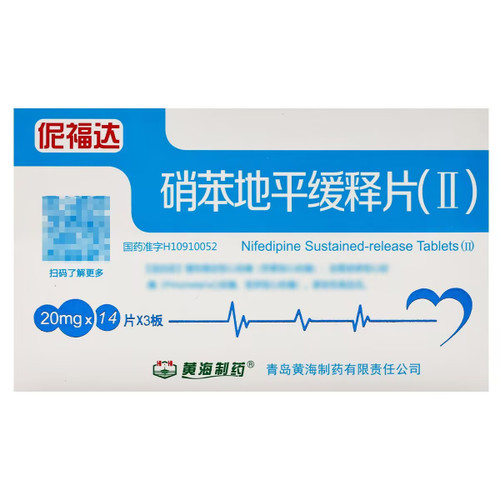Product Overview
Drug Ingredients: Nifedipine
Chemical Components: The main ingredient of this product is nifedipine. Its chemical name is dimethyl 2,6-dimethyl-4-(2-nitrophenyl)-1,4-dihydro-3,5-pyridinedicarboxylate. Molecular formula: C₁₇H₁₇N₂O₆. Molecular weight: 346.34
Properties: This product is a film-coated tablet that appears yellow upon removal of the film coating.
Indications: Various types of hypertension and angina pectoris.
Dosage and Administration: Oral: 10-20 mg twice daily. Maximum dose: 40 mg once daily, 0.12 g daily.
Adverse Reactions:
Liver: Jaundice and elevated glutamate oxaloacetate aminotransferase and glutamate pyruvate aminotransferase levels may occasionally occur. Circulatory System: Chest pain, headache, flushing, dizziness, palpitations, decreased blood pressure, and lower limb edema may occasionally occur. Allergies: Allergic symptoms such as hives and itching may occasionally occur. Digestive System: Abdominal pain, nausea, loss of appetite, and constipation may occasionally occur. Oral: Gingival hypertrophy may occur. Metabolic Abnormalities: Hyperglycemia may occasionally occur.
Contraindications: Not yet known.
Precautions:
When discontinuing calcium channel blockers, the dosage should be gradually reduced. Do not discontinue medication without a doctor's advice. Use with caution in patients with hypotension. Use with caution in patients with severe aortic stenosis, hepatic, or renal insufficiency.
Overdose: Not yet known.
Target Groups:
Contraindicated in pregnant women. Not for children. This study has not been conducted and no reliable references are available.
Drug Interactions: Not yet known.
Manufacturer:
Disa Pharmaceutical Group Co., Ltd.
Pharmacological Action:
This product can dilate coronary arteries in both normal and ischemic areas, antagonize spontaneous or ergonovine-induced coronary artery spasm, increase myocardial oxygen delivery in patients with coronary artery spasm, and relieve and prevent coronary artery spasm. It can also inhibit myocardial contraction, reduce myocardial metabolism, and decrease myocardial oxygen consumption. It can also dilate peripheral resistance vessels, lower peripheral resistance, reduce systolic and diastolic blood pressure, and alleviate cardiac afterload. This product can delay sinoatrial node function and atrioventricular conduction in isolated hearts. Electrophysiological studies in whole animals and humans have not shown that this product delays atrioventricular conduction, prolongs sinus node recovery time, or slows sinus node rate.
Toxicology Studies:
No carcinogenic effects. No mutagenicity. High doses can reduce female rat fertility, cause teratogenicity, and induce abortion (increased fetal drug absorption, increased fetal mortality, and decreased neonatal survival). Administration of 2/3 to 2 times the maximum human dose to pregnant monkeys has resulted in small placentas and chorionic dysplasia. Administration of 3 times the maximum human dose to rats has prolonged gestation.
Pharmacokinetics:
NF is rapidly and completely absorbed from the gastrointestinal tract after oral administration. Due to the hepatic first-pass effect, NF has low bioavailability. Peak plasma concentrations of this sustained-release tablet occur between 1.6 and 4 hours, and the plasma concentration-time curve is flat and prolonged. The minimum effective plasma concentration (10 ng/mL) is maintained for up to 12 hours after each dose. NF has a wide tissue distribution, with higher concentrations in the liver, serum, kidneys, and lungs, and lower concentrations in the brain and skeletal muscle. NF is bound to plasma proteins at rates exceeding 92% to 98% in humans, but its major metabolite has a lower protein binding rate of 54%. NF is oxidized to three pharmacologically inactive metabolites by hepatic microsomal enzymes (including cytochrome P450 monooxygenases). 70% to 80% of the drug is excreted in the urine as water-soluble metabolites, and 90% is eliminated after 24 hours, primarily as unmodified metabolites. Only 0.1% of the unchanged drug is excreted in the urine, indicating no accumulation.
Dosage Form: Tablets
Specifications: 20mg x 36 tablets
Storage: Keep sealed and protected from light.
Expiry Date: 24 months
Approval Number: National Medicine Standard H20083792






